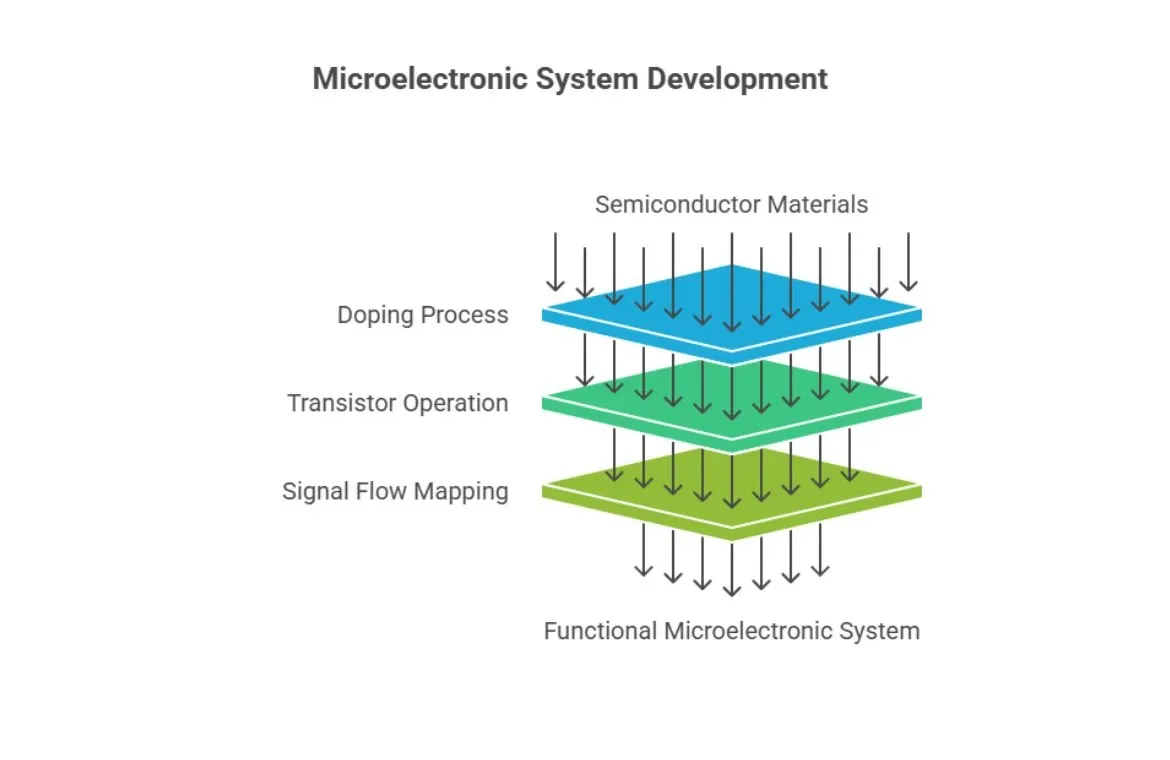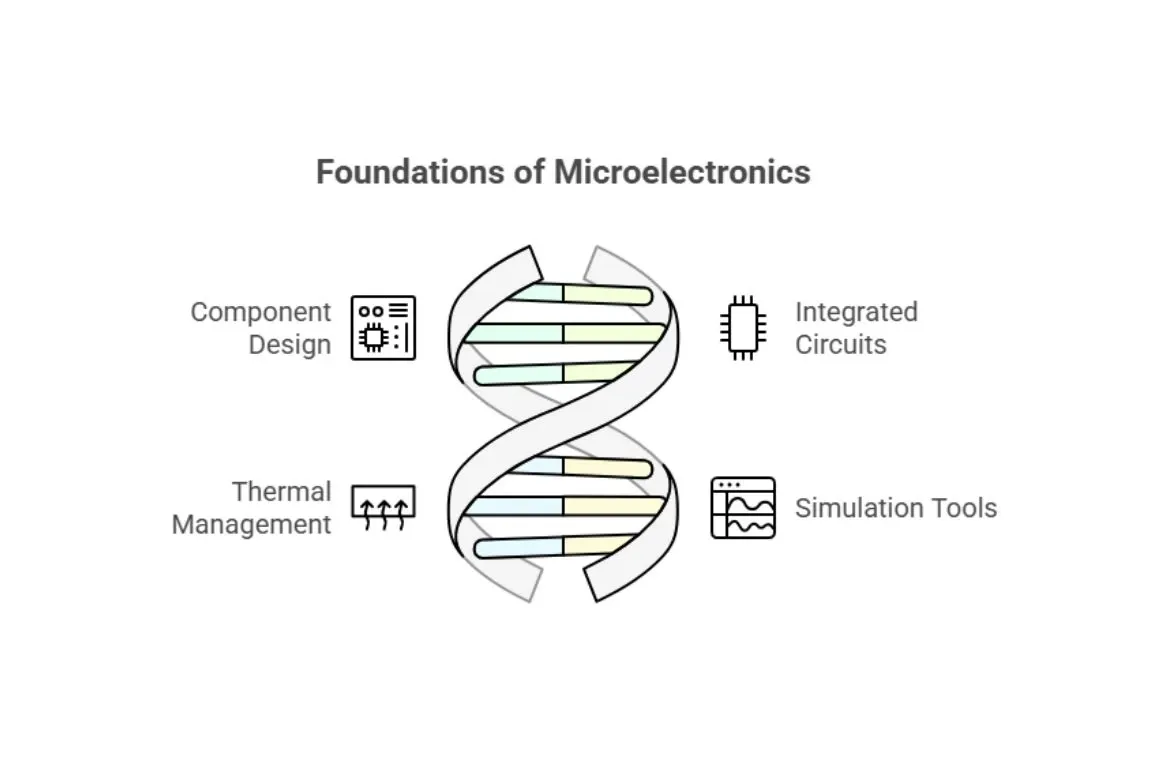What is Microelectronics, and How do they Work in Modern Technology?

Microelectronics might be invisible to the naked eye, but their impact is enormous. From India's booming semiconductor missions to the microchips inside your UPI-powered smartphone, they’ve redefined speed, efficiency, and possibility.
In this blog, we will dive into what microelectronics really is, how it works, and why it is revolutionising everything from mobile devices to smart cities. Whether you're a curious learner or a future engineer, this guide will help you understand the inner workings of modern machines.
What is Microelectronics?
Microelectronics is a branch of electronics that deals with designing and studying extremely small electronic components and devices. These parts operate at the micrometre scale or smaller and utilise semiconductor materials.
A typical microelectronic system has small versions of standard electronic parts such as:
- Transistors, capacitors, inductors, resistors, diodes, and conductors—all shrunk to microscopic sizes
- Integrated circuits (ICs) that pack billions of these parts working as one
- Special connection methods like wire bonding are needed because the parts are so small
At its core, microelectronics applies electronic science to create tiny circuits and parts at the microscopic and molecular levels. These small parts come together to make powerful electronic devices.
Also Read: What is VLSI? Breaking Down Complex Chip Design Simply
Why does it matters in today's tech landscape?
Microelectronics has revolutionised the way tools function in every field, from factory machines and transportation to phones and household appliances.
These tiny parts form the base of key tech breakthroughs. They provide us with the computing power, storage space, and connections necessary for complex systems such as smart cities, smart grids, and Industry 5.0. These parts also drive technologies like AI, machine learning, and IoT.
How Do Microelectronic Systems Work in Modern Technology?

A complex world of electrons flows through engineered pathways beneath the surface of every modern electronic device. Our digital world is powered by microelectronic systems that demonstrate the brilliant application of semiconductor physics and circuit design principles.
1. Semiconductors and doping
Silicon and other semiconductor materials are the lifeblood of the microelectronics industry. These materials conduct electricity at levels between conductors and insulators. Pure semiconductors have limited uses. The process of doping revolutionises their capabilities.
This technique introduces impurities into the semiconductor crystal lattice to alter its electrical properties. N-type and p-type are the two main forms of doping. Silicon has four valence electrons. Adding elements with five valence electrons, like phosphorus or arsenic, creates an n-type semiconductor with negative charge carriers. Elements with three valence electrons, such as boron, create p-type semiconductors with positive "holes".
Electrons can jump between atoms due to the controlled introduction of impurities, which creates an imbalance. This enables electrical conductivity. The relationship needs exact calibration. Higher doping levels boost conductivity but reduce the ease with which carriers move.
2. Transistor operation basics
Transistors regulate electrical signals and work as switches or amplifiers. These devices are nowhere near as simple as they seem. They serve as the building blocks of microelectronics with three terminals. Two main types exist:
- Bipolar Junction Transistors (BJTs): These have base, collector, and emitter terminals. A tiny base current controls a much larger current between the collector and emitter.
- Field-Effect Transistors (FETs): These use gate, source, and drain terminals. The gate voltage controls current flow between the source and the drain.
3. Signal flow in microelectronic circuits
Signal-flow graphs (SFGs) map out signal paths in microelectronic systems. These specialised directed graphs illustrate signal movement through systems.
System variables appear as nodes in these graphs. Branches shown as arrows indicate functional connections between nodes.
Each non-source node combines incoming signals and sends out a resulting signal through outgoing branches. This method works great with Laplace-transformed signals because it represents linear differential equation systems.
Key Elements in Microelectronics Engineering

Engineers must blend several critical engineering elements to create functional microelectronic systems. Microelectronics engineering relies on the delicate balance between tiny components and sophisticated design principles that create reliable, efficient electronic systems.
Designing with transistors, resistors, and capacitors
Microelectronic circuits utilise fundamental building blocks, including transistors, resistors, capacitors, inductors, diodes, and conductors, all operating at microscopic scales. Transistors act as switches or amplifiers that create the foundation of modern electronic devices.
These components control current flow between terminals and enable signal amplification and digital processing. Resistors help regulate current flow to protect components and control signal levels. Capacitors store and release electrical energy, which makes them crucial for filtering, timing, and coupling applications.
Integrated circuits and chip architecture
Silicon-based integrated circuits (ICs) contain electronic circuits etched onto semiconductor material. Digital, analogue, and mixed-signal varieties make up the main IC types. Digital ICs pack billions of logic gates, flip-flops, and multiplexers into a few square millimetres. Analogue ICs handle continuous signals, while mixed-signal circuits combine both continuous and discrete signals.
Thermal design and power management
Heat control presents a major challenge in microelectronics. Components can fail or perform poorly without proper heat management. Engineers apply principles of thermal conduction, convection, radiation, and thermodynamics to keep components at safe temperatures.
The design can utilise passive cooling solutions, such as heat sinks and thermal interface materials, which require no power. Active solutions include forced convection and liquid cooling. Effective thermal management should be an integral part of the initial design process, rather than an afterthought.
Simulation tools and modelling techniques
Modern semiconductor chips contain billions of components that make manual design impossible. Engineers now rely on electronic design automation (EDA) software to design, verify, and analyse entire semiconductor chips. Innovative EDA tools now utilise artificial intelligence to enhance efficiency and improve chip performance.
Real-World Applications Across Industries
Microelectronics powers breakthroughs in many sectors and enables technologies that shape modern life. The miniaturisation and integration of electronic components have led to sophisticated systems with increasingly sophisticated capabilities across various industries.
Smartphones and computing devices
Today's smartphones contain billions of transistors that process massive amounts of data, enabling voice recognition and fitness tracking capabilities. These compact yet powerful devices demonstrate how microelectronics engineering has made computing more accessible while significantly boosting processing power.
Automotive electronics and safety systems
The automotive sector's critical safety and performance features rely on microelectronics as their foundation. Advanced Driver Assistance Systems (ADAS), Anti-lock Braking Systems (ABS), and Electronic Stability Control (ESC) need microelectronic components.
Healthcare innovations and wearables
Healthcare has seen the development of revolutionary medical devices and diagnostic tools powered by microelectronics. Wearable biosensors with edge-computing capabilities process data locally, providing up-to-the-minute monitoring without requiring constant network connectivity.
Telecommunications and networking
Telecommunication infrastructure heavily depends on microelectronic systems to process signals and transmit data. Broadband networks, wireless communication systems, and networking equipment use specialised microelectronic components.
Aerospace and defence systems
Aerospace applications need extraordinary reliability from electronic components. Radiation-hardened integrated circuits provide performance and mission assurance in space and other radiation-prone environments.
Benefits, Limitations, and the Road Ahead
The rise of microelectronics has brought about remarkable breakthroughs and core challenges that have transformed the landscape of our tech world. A deeper examination of its capabilities and limitations helps us understand what lies ahead.
Advantages of microelectronics in modern tech
Modern technology has undergone significant changes due to the benefits of microelectronics. We created much smaller devices that work better, and last longer.
Circuit designs have become more compact, and electrical signals now travel shorter distances, resulting in faster performance. These devices require less power than their older counterparts.
Microelectronics' flexibility lets us pack more features into smaller spaces. This size reduction helped create powerful computers and phones that old components could never achieve.
Limitations of Miniaturisation
1. Physical Limits of Scaling
- Early microelectronics benefited from simple MOSFET scaling, which worked well until around the 180 nm node (circa 2000).
- Beyond this, component sizes approached atomic dimensions, making pattern formation via lithography extremely complex.
2. Lithography Challenges
- As feature sizes shrink, it becomes increasingly difficult to precisely etch patterns on silicon wafers, due to limitations in light wavelengths and equipment precision.
3. Voltage Scaling Issues
- The supply voltage was expected to decrease proportionally with size, but this is no longer practical.
- Lowering the threshold voltage causes leakage currents to rise exponentially, undermining energy efficiency.
Future of microelectronics in AI and quantum computing
Quantum computing might be the next big leap in processing power. Unlike regular computers, which use binary logic, quantum computers utilise qubits that exist in multiple states simultaneously, thanks to the principles of superposition and entanglement.
AI and quantum computing combined could improve healthcare through better diagnosis and drug research, enhance financial systems, optimise logistics networks, and enhance climate modelling.
Economic and societal impact
Corporate teams now collaborate across the globe through video calls, instant messages, and social platforms. These tools have transformed the way work is divided internationally, affecting the majority of the world's workers.
Sustainability and green electronics
Environmental concerns now drive microelectronics development. Energy-efficient components have improved, but the rapid growth of microelectronics continues to push up total energy use in information and communication technology.
New adaptive systems, data centres, and more IoT devices exacerbate these challenges.
Green electronics aims to create eco-friendly products through environmentally responsible design, manufacturing and disposal.
This approach utilises biodegradable materials, energy-efficient production, promotes recycling, and ensures proper disposal to protect the environment.
Conclusion
Microelectronics may begin at the nanoscale, but their ripple effects touch every sector, from healthcare to aerospace. As complexity grows, so does the need for skilled professionals who can translate science into scalable impact.
This is where advanced learning plays a pivotal role. The Advanced certification programme in Microelectronics and Semiconductor Technologies is designed not just for academic enrichment but to meet the growing demands of R&D labs, industry professionals, research scientists, and engineers alike. They equip learners with the insights needed to thrive in data-driven and technology-intensive environments, where success is not just about knowing the technology, but mastering it.
Hence, Microelectronic parts may be too small to see, but their combined effect shapes our world. A good grasp of these core technologies gives you valuable insights, whatever your technical role might be.
Frequently Asked Questions
Q1. What is microelectronics, and why is it important in modern technology?
Microelectronics is the branch of electronics dealing with extremely small components and circuits integrated on semiconductor materials. It's crucial in modern technology, as it enables the miniaturisation of devices, enhances performance, improves energy efficiency, and facilitates connectivity across various sectors, including computing, communications, and healthcare.
Q2. How do microelectronic systems work?
Microelectronic systems work through the controlled flow of electrons in semiconductor materials. They utilise components such as transistors, resistors, and capacitors to process and transmit electrical signals. The operation involves manipulating the electrical properties of materials through techniques like doping and creating integrated circuits that can perform complex functions.
Q3. What are some key applications of microelectronics in everyday life?
Microelectronics are ubiquitous in modern life, powering devices like smartphones, computers, and wearable technology. They're also crucial in automotive electronics, medical devices, telecommunications equipment, and aerospace systems. Microelectronics enable the smart, compact, and efficient devices we rely on daily.

TalentSprint
TalentSprint is a leading deep-tech education company. It partners with esteemed academic institutions and global corporations to offer advanced learning programs in deep-tech, management, and emerging technologies. Known for its high-impact programs co-created with think tanks and experts, TalentSprint blends academic expertise with practical industry experience.



